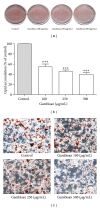Effect of Gambisan on the Inhibition of Adipogenesis in 3T3-L1 Adipocytes
- PMID: 24069055
- PMCID: PMC3773429
- DOI: 10.1155/2013/789067
Effect of Gambisan on the Inhibition of Adipogenesis in 3T3-L1 Adipocytes
Abstract
This study was conducted to explore the antiadipogenic effect and possible mechanism of Gambisan on 3T3-L1 cells. For quality control, Gambisan was standardized by HPLC and the standard compounds ephedrine, epigallocatechin-3-gallate, and caffeine were screened. Cultured 3T3-L1 cells that had been induced to differentiate were treated with various concentrations of Gambisan or its major component extracts (Ephedra intermedia Schrenk, Atractylodes lancea DC., and Thea sinensis L.) for 72 hours for MTT assay to determine cell viability or 10 days for LDH assay, triglyceride assay, DNA content measurement, Oil red O staining, RT-PCR, and western blot. Gambisan significantly inhibited adipogenesis in 3T3-L1 cells by reducing triglyceride contents and lipid accumulation in a dose-dependent manner without obvious cytotoxicity. Viability and DNA content in 3T3-L1 cells treated with Gambisan were significantly higher than cells treated with the major component extracts at every concentration. The anti-adipogenic effects of Gambisan appeared to be mediated by a significant downregulation of the expression of lipoprotein lipase mRNA and PPAR γ , C/EBP α , and SREBP-1 protein apart from the expression of hormone-sensitive lipase. Gambisan could act as a possible therapeutic agent for obesity. However, further studies including in vivo assays and clinical trials are needed to confirm the efficacy, safety and mechanisms of the antiobesity effects of Gambisan.
Figures





References
-
- Kopelman PG. Obesity as a medical problem. Nature. 2000;404(6778):635–643. - PubMed
-
- Yanovski SZ, Yanovski JA. Obesity. New England Journal of Medicine. 2002;346(8):591–602. - PubMed
-
- Hong Y, Kim M, Yoon M. The anti-angiogenic herbal extracts Ob-X from Morus alba, Melissa officinalis, and Artemisia capillaris suppresses adipogenesis in 3T3-L1 adipocytes. Pharmaceutical Biology. 2011;49(8):775–783. - PubMed
-
- Frühbeck G, Gómez-Ambrosi J, Muruzábal FJ, Burrell MA. The adipocyte: a model for integration of endocrine and metabolic signaling in energy metabolism regulation. American Journal of Physiology-Endocrinology and Metabolism. 2001;280(6):E827–E847. - PubMed
-
- Lin J, Della-Fera MA, Baile CA. Green tea polyphenol epigallocatechin gallate inhibits adipogenesis and induces apoptosis in 3T3-L1 adipocytes. Obesity Research. 2005;13(6):982–990. - PubMed
LinkOut - more resources
Full Text Sources
Other Literature Sources

